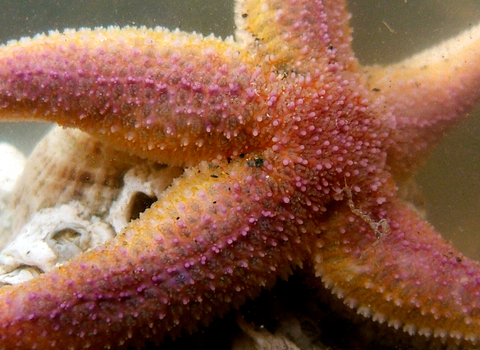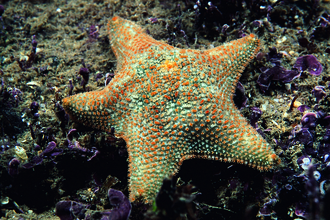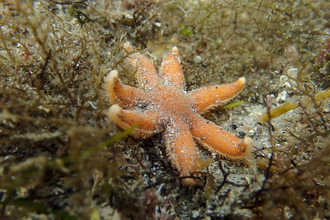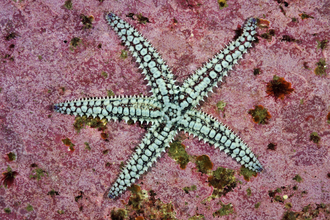
Starfish by Alan Price

Common Starfish ©Paul Naylor www.marinephoto.co.uk
Common starfish
A most familiar seashore inhabitant, the common starfish truly lives up to its name in UK seas and rockpools!
Scientific name
Asterias rubensWhen to see
January to DecemberSpecies information
Category
Statistics
Diameter: 10-30cm Average Lifespan: 5-10 yearsConservation status
Common
About
The common starfish is highly common in UK seas, found in rockpools and out at sea to depths of at least 600m. They are active predators, feasting on bivalves such as mussels and clams. As such, they have been known to become a bit of a pest on mussel and oyster beds! Starfish feed on shellfish by pulling the shells open with their arms, inserting their own stomach into the shell and dissolving their prey with digestive juices, before reabsorbing their stomach full of the shellfish soup.Starfish will form huge aggregations when food is plentiful, drawn in by their keen sense of smell. They don't have a nose - they use special receptors in their skin!. Starfish aren't really fish, they are a type of sea creature called an echinoderm, which means "spiny skinned". Echinoderms includes starfish, sea urchins, sea cucumbers and brittlestars.
How to identify
The common starfish has five arms, is usually orange in colour, and has many small pale spines. It is often found washed up on the shore after rough seas, sometimes in great numbers.Distribution
Found on all British and Irish coasts, particularly among beds of mussels.Did you know?
Starfish have an amazing ability to regenerate lost limbs - meaning you'll sometimes spot a starfish with 4 normal sized legs and 1 small leg. The small leg is regrowing! Starfish will sometimes shed a leg to escape a predator and will then regrow the missing leg or legs. They can do this so long as at least some of their central disc is intact. So, if you cut a starfish in half, if both halves had part of the central disc in tact, they could both regrow into genetically identical starfish.How people can help
When rockpooling, be careful to leave everything as you found it - replace any seaweed you move out of the way, put back any crabs or fish and ensure not to scrape anything off its rocky home. If you want to learn more about our rockpool life, Wildlife Trusts around the UK run rockpool safaris and offer Shoresearch training - teaching you to survey your local rocky shore. The data collected is then used to protect our coasts and seas through better management or through the designation of Marine Protected Areas.
Common starfish, digging for prey ©Paul Naylor www.marinephoto.co.uk

Common Starfish ©Paul Naylor www.marinephoto.co.uk






